Personality Traits and Their Implications on Organizational Behaviour
VerifiedAdded on 2023/06/06
|11
|2095
|85
AI Summary
The report analyses the importance of personality traits in organizational behaviour, discussing nomothetic and idiographic personalities, real-world examples, and implications on organizations.
Contribute Materials
Your contribution can guide someone’s learning journey. Share your
documents today.
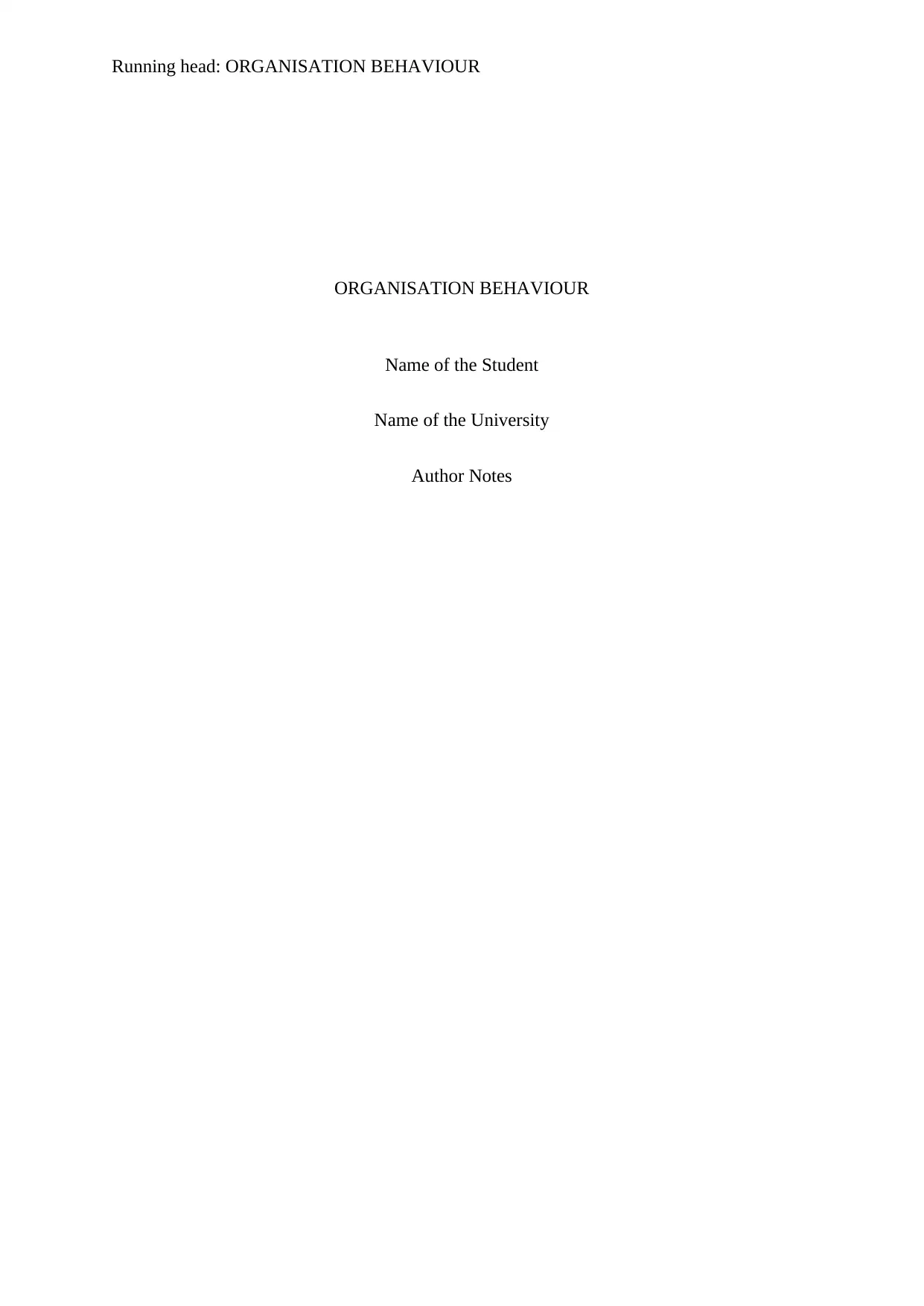
Running head: ORGANISATION BEHAVIOUR
ORGANISATION BEHAVIOUR
Name of the Student
Name of the University
Author Notes
ORGANISATION BEHAVIOUR
Name of the Student
Name of the University
Author Notes
Secure Best Marks with AI Grader
Need help grading? Try our AI Grader for instant feedback on your assignments.
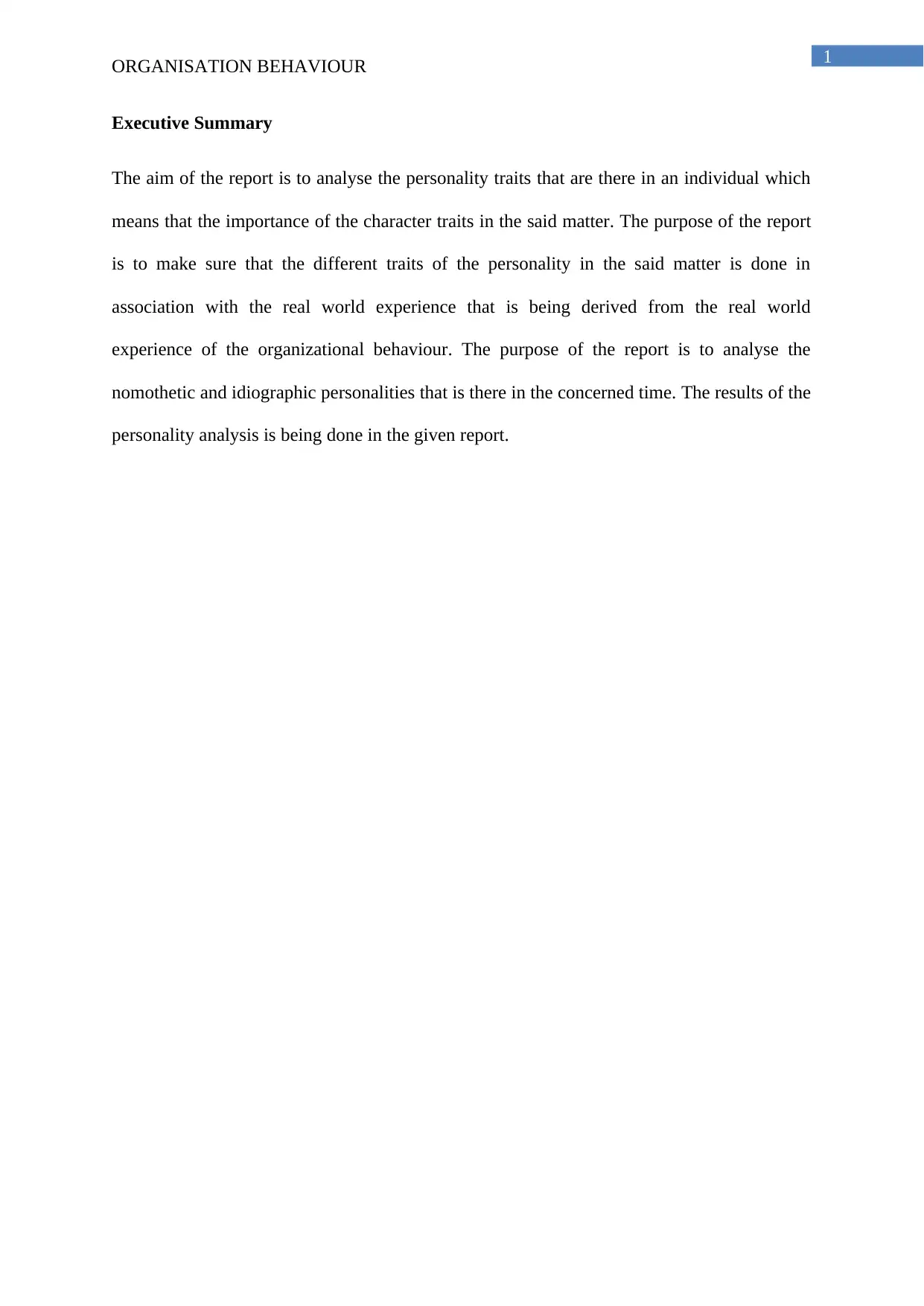
1
ORGANISATION BEHAVIOUR
Executive Summary
The aim of the report is to analyse the personality traits that are there in an individual which
means that the importance of the character traits in the said matter. The purpose of the report
is to make sure that the different traits of the personality in the said matter is done in
association with the real world experience that is being derived from the real world
experience of the organizational behaviour. The purpose of the report is to analyse the
nomothetic and idiographic personalities that is there in the concerned time. The results of the
personality analysis is being done in the given report.
ORGANISATION BEHAVIOUR
Executive Summary
The aim of the report is to analyse the personality traits that are there in an individual which
means that the importance of the character traits in the said matter. The purpose of the report
is to make sure that the different traits of the personality in the said matter is done in
association with the real world experience that is being derived from the real world
experience of the organizational behaviour. The purpose of the report is to analyse the
nomothetic and idiographic personalities that is there in the concerned time. The results of the
personality analysis is being done in the given report.
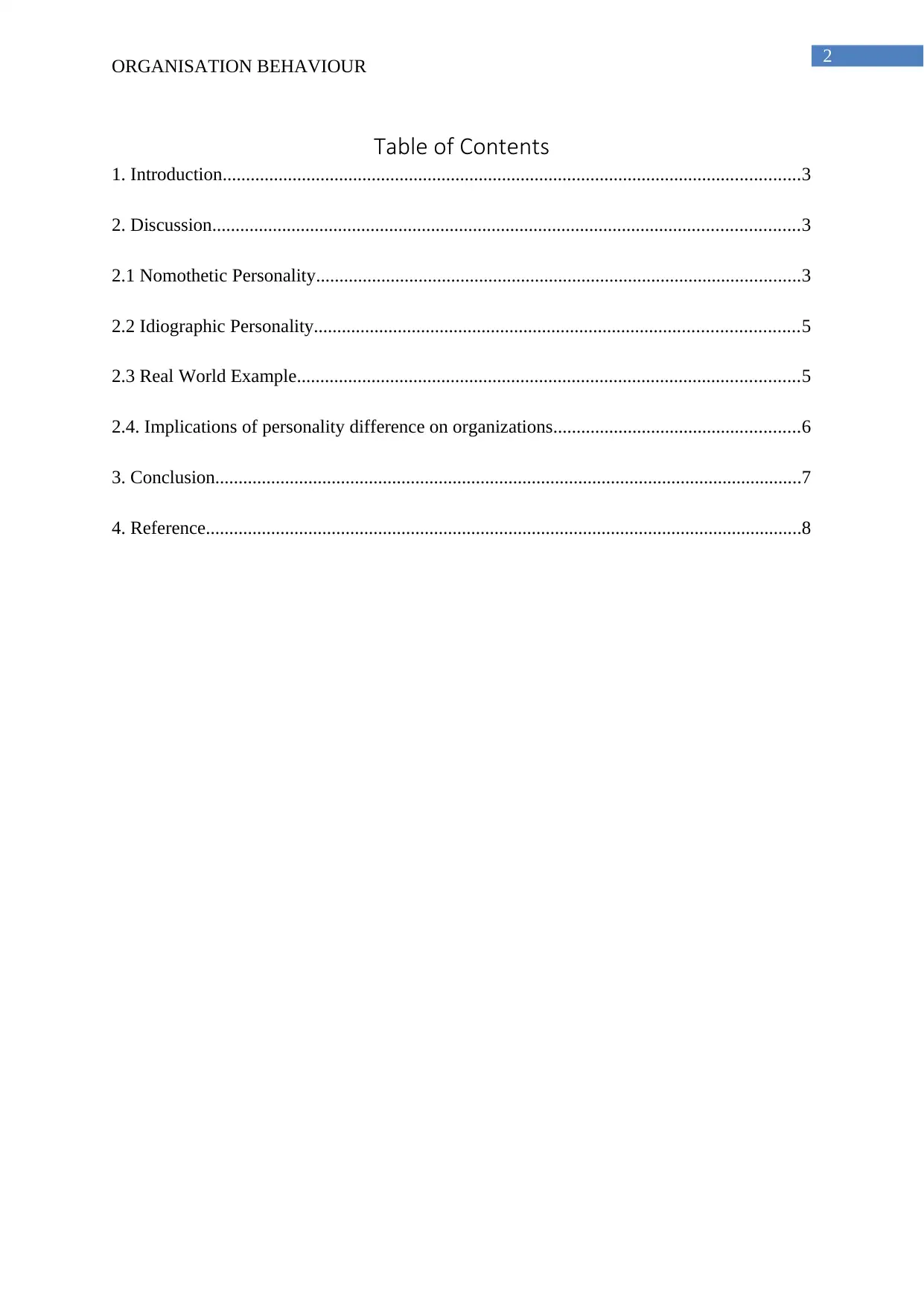
2
ORGANISATION BEHAVIOUR
Table of Contents
1. Introduction............................................................................................................................3
2. Discussion..............................................................................................................................3
2.1 Nomothetic Personality........................................................................................................3
2.2 Idiographic Personality........................................................................................................5
2.3 Real World Example............................................................................................................5
2.4. Implications of personality difference on organizations.....................................................6
3. Conclusion..............................................................................................................................7
4. Reference................................................................................................................................8
ORGANISATION BEHAVIOUR
Table of Contents
1. Introduction............................................................................................................................3
2. Discussion..............................................................................................................................3
2.1 Nomothetic Personality........................................................................................................3
2.2 Idiographic Personality........................................................................................................5
2.3 Real World Example............................................................................................................5
2.4. Implications of personality difference on organizations.....................................................6
3. Conclusion..............................................................................................................................7
4. Reference................................................................................................................................8
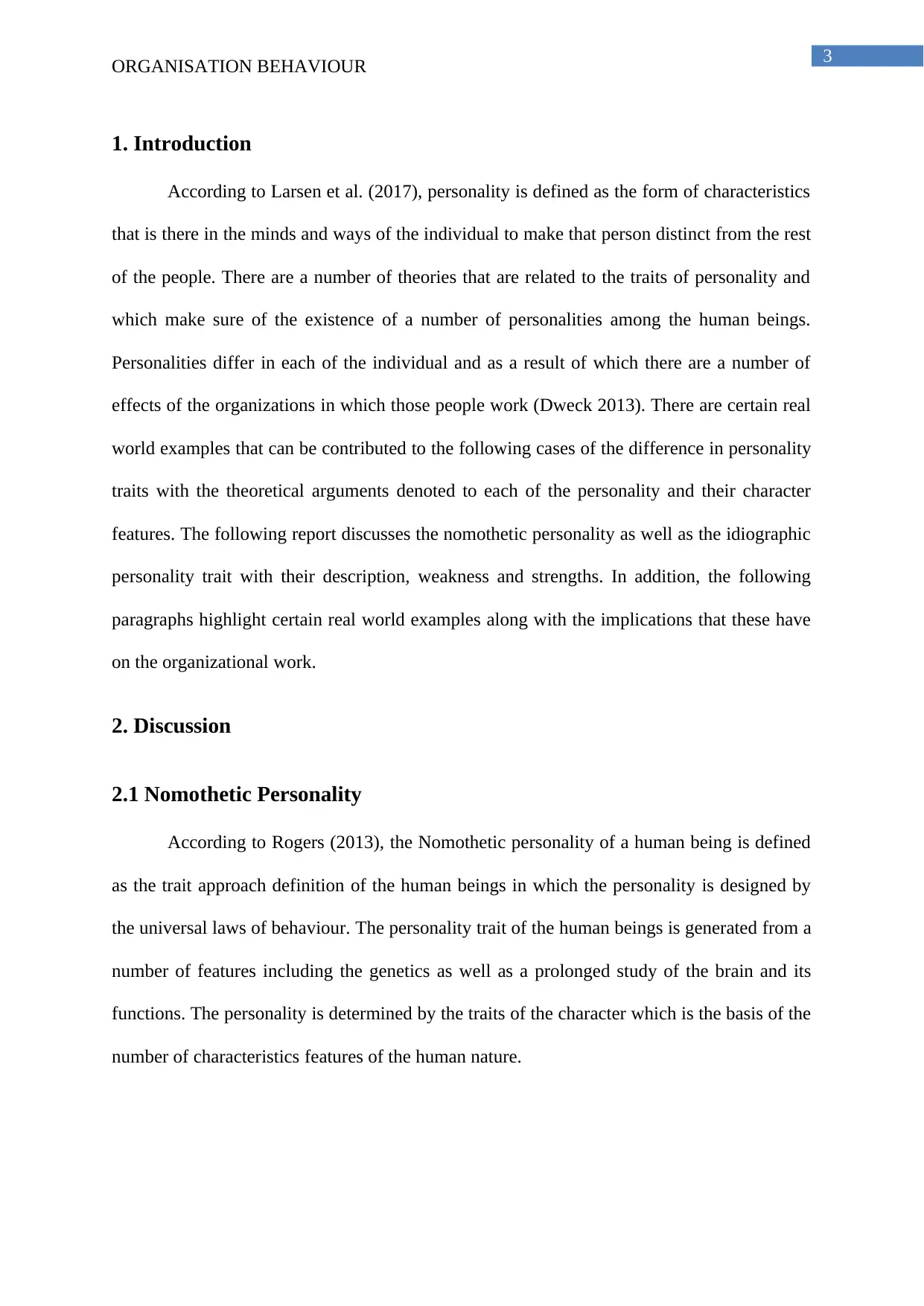
3
ORGANISATION BEHAVIOUR
1. Introduction
According to Larsen et al. (2017), personality is defined as the form of characteristics
that is there in the minds and ways of the individual to make that person distinct from the rest
of the people. There are a number of theories that are related to the traits of personality and
which make sure of the existence of a number of personalities among the human beings.
Personalities differ in each of the individual and as a result of which there are a number of
effects of the organizations in which those people work (Dweck 2013). There are certain real
world examples that can be contributed to the following cases of the difference in personality
traits with the theoretical arguments denoted to each of the personality and their character
features. The following report discusses the nomothetic personality as well as the idiographic
personality trait with their description, weakness and strengths. In addition, the following
paragraphs highlight certain real world examples along with the implications that these have
on the organizational work.
2. Discussion
2.1 Nomothetic Personality
According to Rogers (2013), the Nomothetic personality of a human being is defined
as the trait approach definition of the human beings in which the personality is designed by
the universal laws of behaviour. The personality trait of the human beings is generated from a
number of features including the genetics as well as a prolonged study of the brain and its
functions. The personality is determined by the traits of the character which is the basis of the
number of characteristics features of the human nature.
ORGANISATION BEHAVIOUR
1. Introduction
According to Larsen et al. (2017), personality is defined as the form of characteristics
that is there in the minds and ways of the individual to make that person distinct from the rest
of the people. There are a number of theories that are related to the traits of personality and
which make sure of the existence of a number of personalities among the human beings.
Personalities differ in each of the individual and as a result of which there are a number of
effects of the organizations in which those people work (Dweck 2013). There are certain real
world examples that can be contributed to the following cases of the difference in personality
traits with the theoretical arguments denoted to each of the personality and their character
features. The following report discusses the nomothetic personality as well as the idiographic
personality trait with their description, weakness and strengths. In addition, the following
paragraphs highlight certain real world examples along with the implications that these have
on the organizational work.
2. Discussion
2.1 Nomothetic Personality
According to Rogers (2013), the Nomothetic personality of a human being is defined
as the trait approach definition of the human beings in which the personality is designed by
the universal laws of behaviour. The personality trait of the human beings is generated from a
number of features including the genetics as well as a prolonged study of the brain and its
functions. The personality is determined by the traits of the character which is the basis of the
number of characteristics features of the human nature.
Secure Best Marks with AI Grader
Need help grading? Try our AI Grader for instant feedback on your assignments.
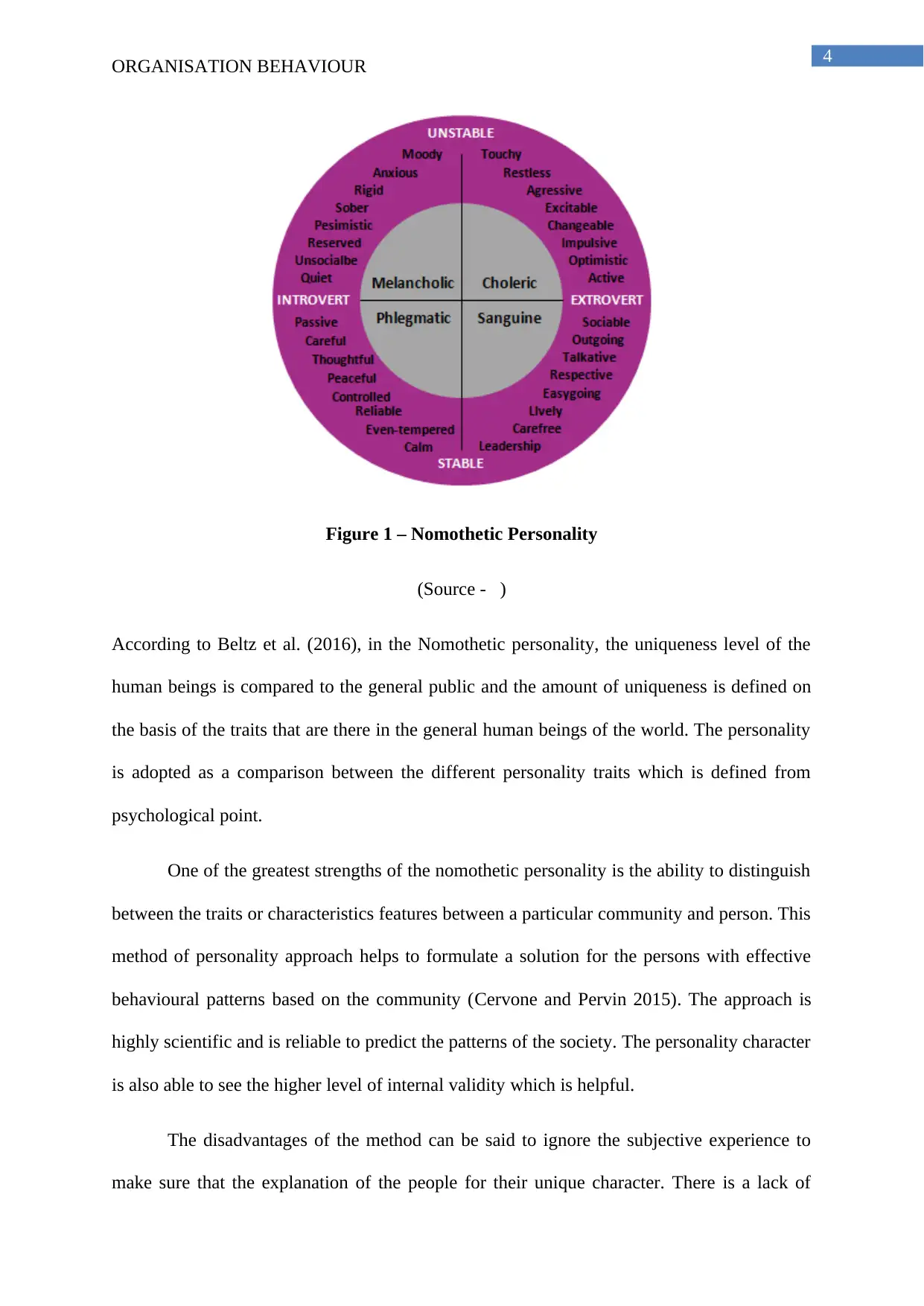
4
ORGANISATION BEHAVIOUR
Figure 1 – Nomothetic Personality
(Source - )
According to Beltz et al. (2016), in the Nomothetic personality, the uniqueness level of the
human beings is compared to the general public and the amount of uniqueness is defined on
the basis of the traits that are there in the general human beings of the world. The personality
is adopted as a comparison between the different personality traits which is defined from
psychological point.
One of the greatest strengths of the nomothetic personality is the ability to distinguish
between the traits or characteristics features between a particular community and person. This
method of personality approach helps to formulate a solution for the persons with effective
behavioural patterns based on the community (Cervone and Pervin 2015). The approach is
highly scientific and is reliable to predict the patterns of the society. The personality character
is also able to see the higher level of internal validity which is helpful.
The disadvantages of the method can be said to ignore the subjective experience to
make sure that the explanation of the people for their unique character. There is a lack of
ORGANISATION BEHAVIOUR
Figure 1 – Nomothetic Personality
(Source - )
According to Beltz et al. (2016), in the Nomothetic personality, the uniqueness level of the
human beings is compared to the general public and the amount of uniqueness is defined on
the basis of the traits that are there in the general human beings of the world. The personality
is adopted as a comparison between the different personality traits which is defined from
psychological point.
One of the greatest strengths of the nomothetic personality is the ability to distinguish
between the traits or characteristics features between a particular community and person. This
method of personality approach helps to formulate a solution for the persons with effective
behavioural patterns based on the community (Cervone and Pervin 2015). The approach is
highly scientific and is reliable to predict the patterns of the society. The personality character
is also able to see the higher level of internal validity which is helpful.
The disadvantages of the method can be said to ignore the subjective experience to
make sure that the explanation of the people for their unique character. There is a lack of
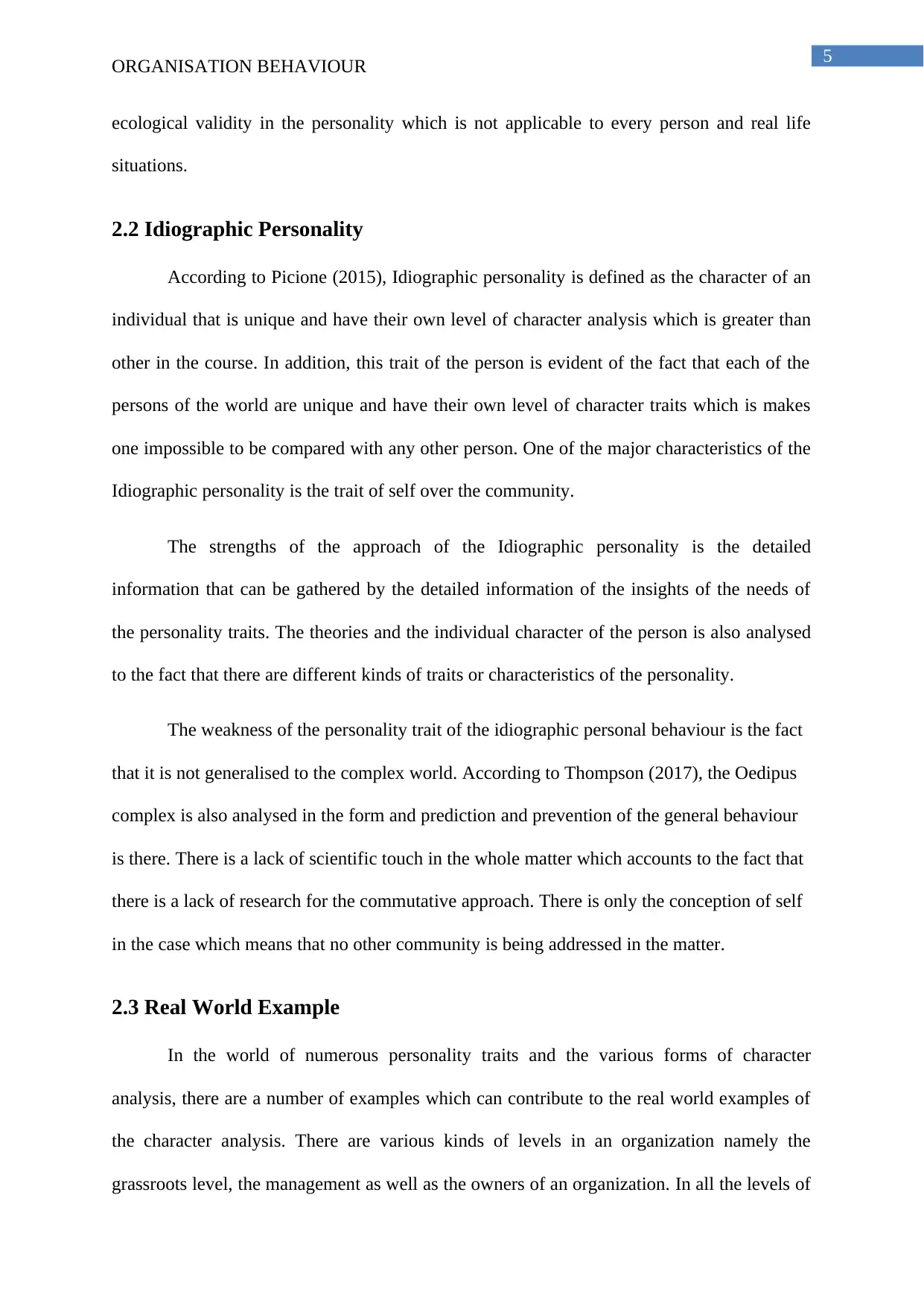
5
ORGANISATION BEHAVIOUR
ecological validity in the personality which is not applicable to every person and real life
situations.
2.2 Idiographic Personality
According to Picione (2015), Idiographic personality is defined as the character of an
individual that is unique and have their own level of character analysis which is greater than
other in the course. In addition, this trait of the person is evident of the fact that each of the
persons of the world are unique and have their own level of character traits which is makes
one impossible to be compared with any other person. One of the major characteristics of the
Idiographic personality is the trait of self over the community.
The strengths of the approach of the Idiographic personality is the detailed
information that can be gathered by the detailed information of the insights of the needs of
the personality traits. The theories and the individual character of the person is also analysed
to the fact that there are different kinds of traits or characteristics of the personality.
The weakness of the personality trait of the idiographic personal behaviour is the fact
that it is not generalised to the complex world. According to Thompson (2017), the Oedipus
complex is also analysed in the form and prediction and prevention of the general behaviour
is there. There is a lack of scientific touch in the whole matter which accounts to the fact that
there is a lack of research for the commutative approach. There is only the conception of self
in the case which means that no other community is being addressed in the matter.
2.3 Real World Example
In the world of numerous personality traits and the various forms of character
analysis, there are a number of examples which can contribute to the real world examples of
the character analysis. There are various kinds of levels in an organization namely the
grassroots level, the management as well as the owners of an organization. In all the levels of
ORGANISATION BEHAVIOUR
ecological validity in the personality which is not applicable to every person and real life
situations.
2.2 Idiographic Personality
According to Picione (2015), Idiographic personality is defined as the character of an
individual that is unique and have their own level of character analysis which is greater than
other in the course. In addition, this trait of the person is evident of the fact that each of the
persons of the world are unique and have their own level of character traits which is makes
one impossible to be compared with any other person. One of the major characteristics of the
Idiographic personality is the trait of self over the community.
The strengths of the approach of the Idiographic personality is the detailed
information that can be gathered by the detailed information of the insights of the needs of
the personality traits. The theories and the individual character of the person is also analysed
to the fact that there are different kinds of traits or characteristics of the personality.
The weakness of the personality trait of the idiographic personal behaviour is the fact
that it is not generalised to the complex world. According to Thompson (2017), the Oedipus
complex is also analysed in the form and prediction and prevention of the general behaviour
is there. There is a lack of scientific touch in the whole matter which accounts to the fact that
there is a lack of research for the commutative approach. There is only the conception of self
in the case which means that no other community is being addressed in the matter.
2.3 Real World Example
In the world of numerous personality traits and the various forms of character
analysis, there are a number of examples which can contribute to the real world examples of
the character analysis. There are various kinds of levels in an organization namely the
grassroots level, the management as well as the owners of an organization. In all the levels of
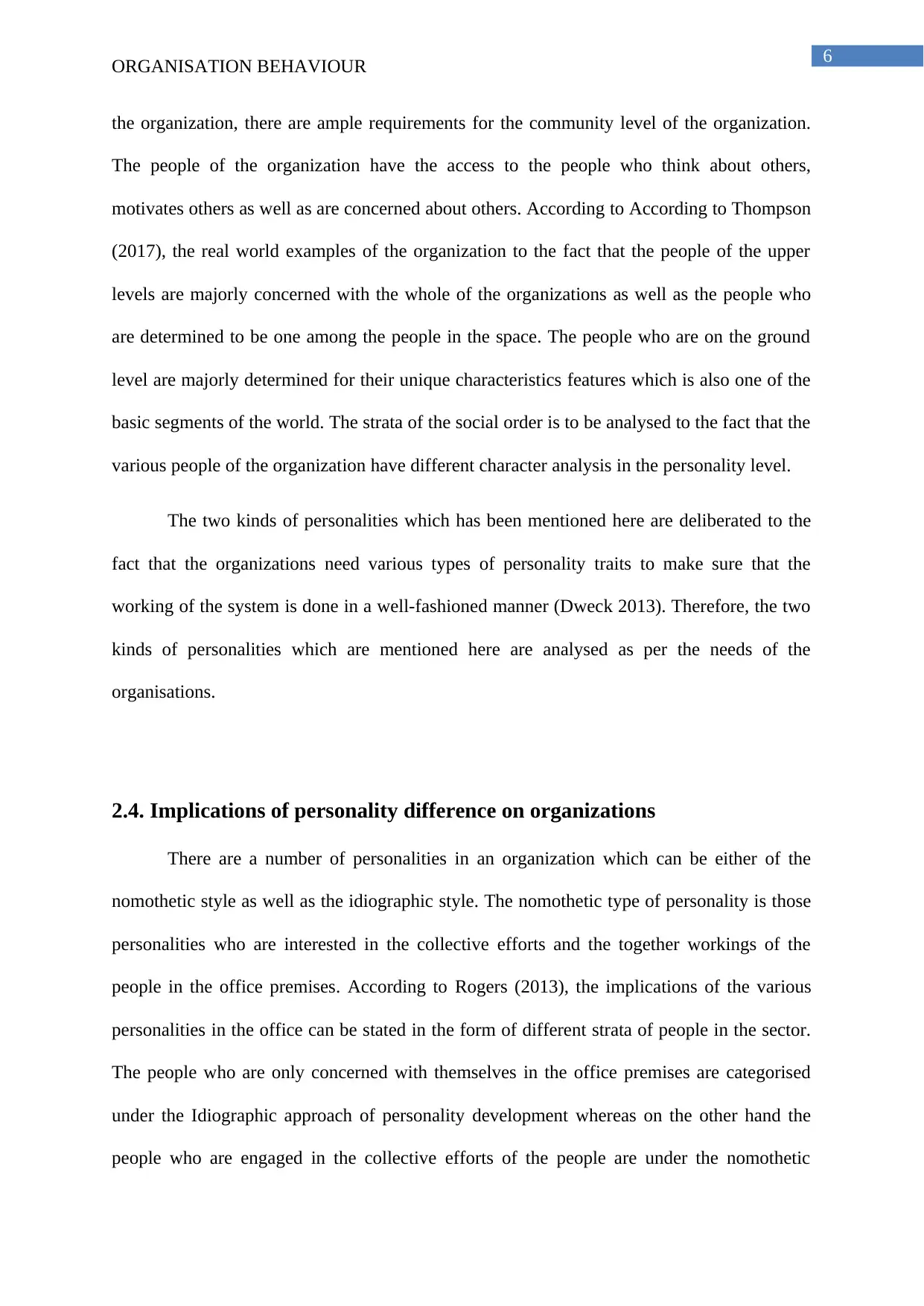
6
ORGANISATION BEHAVIOUR
the organization, there are ample requirements for the community level of the organization.
The people of the organization have the access to the people who think about others,
motivates others as well as are concerned about others. According to According to Thompson
(2017), the real world examples of the organization to the fact that the people of the upper
levels are majorly concerned with the whole of the organizations as well as the people who
are determined to be one among the people in the space. The people who are on the ground
level are majorly determined for their unique characteristics features which is also one of the
basic segments of the world. The strata of the social order is to be analysed to the fact that the
various people of the organization have different character analysis in the personality level.
The two kinds of personalities which has been mentioned here are deliberated to the
fact that the organizations need various types of personality traits to make sure that the
working of the system is done in a well-fashioned manner (Dweck 2013). Therefore, the two
kinds of personalities which are mentioned here are analysed as per the needs of the
organisations.
2.4. Implications of personality difference on organizations
There are a number of personalities in an organization which can be either of the
nomothetic style as well as the idiographic style. The nomothetic type of personality is those
personalities who are interested in the collective efforts and the together workings of the
people in the office premises. According to Rogers (2013), the implications of the various
personalities in the office can be stated in the form of different strata of people in the sector.
The people who are only concerned with themselves in the office premises are categorised
under the Idiographic approach of personality development whereas on the other hand the
people who are engaged in the collective efforts of the people are under the nomothetic
ORGANISATION BEHAVIOUR
the organization, there are ample requirements for the community level of the organization.
The people of the organization have the access to the people who think about others,
motivates others as well as are concerned about others. According to According to Thompson
(2017), the real world examples of the organization to the fact that the people of the upper
levels are majorly concerned with the whole of the organizations as well as the people who
are determined to be one among the people in the space. The people who are on the ground
level are majorly determined for their unique characteristics features which is also one of the
basic segments of the world. The strata of the social order is to be analysed to the fact that the
various people of the organization have different character analysis in the personality level.
The two kinds of personalities which has been mentioned here are deliberated to the
fact that the organizations need various types of personality traits to make sure that the
working of the system is done in a well-fashioned manner (Dweck 2013). Therefore, the two
kinds of personalities which are mentioned here are analysed as per the needs of the
organisations.
2.4. Implications of personality difference on organizations
There are a number of personalities in an organization which can be either of the
nomothetic style as well as the idiographic style. The nomothetic type of personality is those
personalities who are interested in the collective efforts and the together workings of the
people in the office premises. According to Rogers (2013), the implications of the various
personalities in the office can be stated in the form of different strata of people in the sector.
The people who are only concerned with themselves in the office premises are categorised
under the Idiographic approach of personality development whereas on the other hand the
people who are engaged in the collective efforts of the people are under the nomothetic
Paraphrase This Document
Need a fresh take? Get an instant paraphrase of this document with our AI Paraphraser
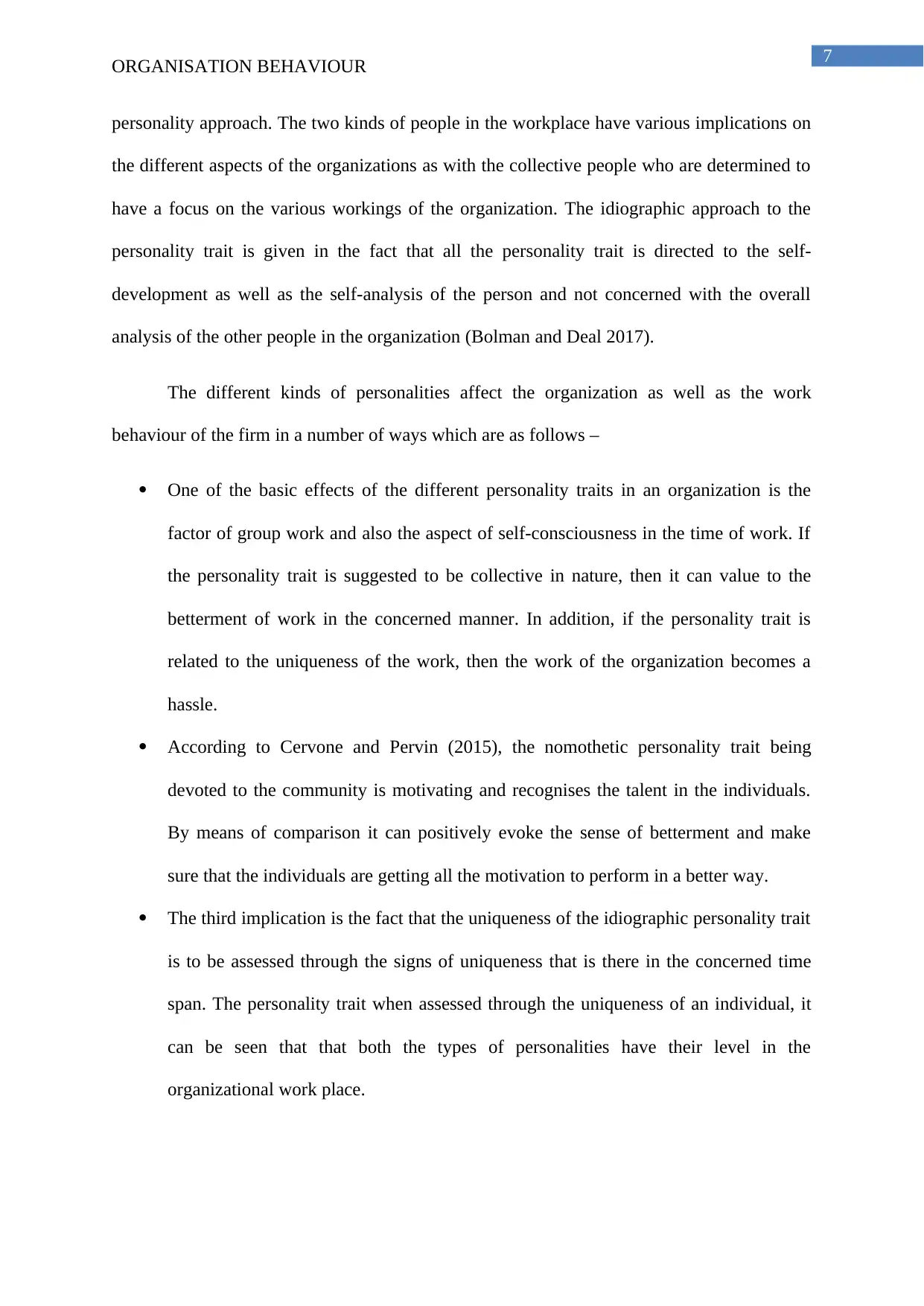
7
ORGANISATION BEHAVIOUR
personality approach. The two kinds of people in the workplace have various implications on
the different aspects of the organizations as with the collective people who are determined to
have a focus on the various workings of the organization. The idiographic approach to the
personality trait is given in the fact that all the personality trait is directed to the self-
development as well as the self-analysis of the person and not concerned with the overall
analysis of the other people in the organization (Bolman and Deal 2017).
The different kinds of personalities affect the organization as well as the work
behaviour of the firm in a number of ways which are as follows –
One of the basic effects of the different personality traits in an organization is the
factor of group work and also the aspect of self-consciousness in the time of work. If
the personality trait is suggested to be collective in nature, then it can value to the
betterment of work in the concerned manner. In addition, if the personality trait is
related to the uniqueness of the work, then the work of the organization becomes a
hassle.
According to Cervone and Pervin (2015), the nomothetic personality trait being
devoted to the community is motivating and recognises the talent in the individuals.
By means of comparison it can positively evoke the sense of betterment and make
sure that the individuals are getting all the motivation to perform in a better way.
The third implication is the fact that the uniqueness of the idiographic personality trait
is to be assessed through the signs of uniqueness that is there in the concerned time
span. The personality trait when assessed through the uniqueness of an individual, it
can be seen that that both the types of personalities have their level in the
organizational work place.
ORGANISATION BEHAVIOUR
personality approach. The two kinds of people in the workplace have various implications on
the different aspects of the organizations as with the collective people who are determined to
have a focus on the various workings of the organization. The idiographic approach to the
personality trait is given in the fact that all the personality trait is directed to the self-
development as well as the self-analysis of the person and not concerned with the overall
analysis of the other people in the organization (Bolman and Deal 2017).
The different kinds of personalities affect the organization as well as the work
behaviour of the firm in a number of ways which are as follows –
One of the basic effects of the different personality traits in an organization is the
factor of group work and also the aspect of self-consciousness in the time of work. If
the personality trait is suggested to be collective in nature, then it can value to the
betterment of work in the concerned manner. In addition, if the personality trait is
related to the uniqueness of the work, then the work of the organization becomes a
hassle.
According to Cervone and Pervin (2015), the nomothetic personality trait being
devoted to the community is motivating and recognises the talent in the individuals.
By means of comparison it can positively evoke the sense of betterment and make
sure that the individuals are getting all the motivation to perform in a better way.
The third implication is the fact that the uniqueness of the idiographic personality trait
is to be assessed through the signs of uniqueness that is there in the concerned time
span. The personality trait when assessed through the uniqueness of an individual, it
can be seen that that both the types of personalities have their level in the
organizational work place.
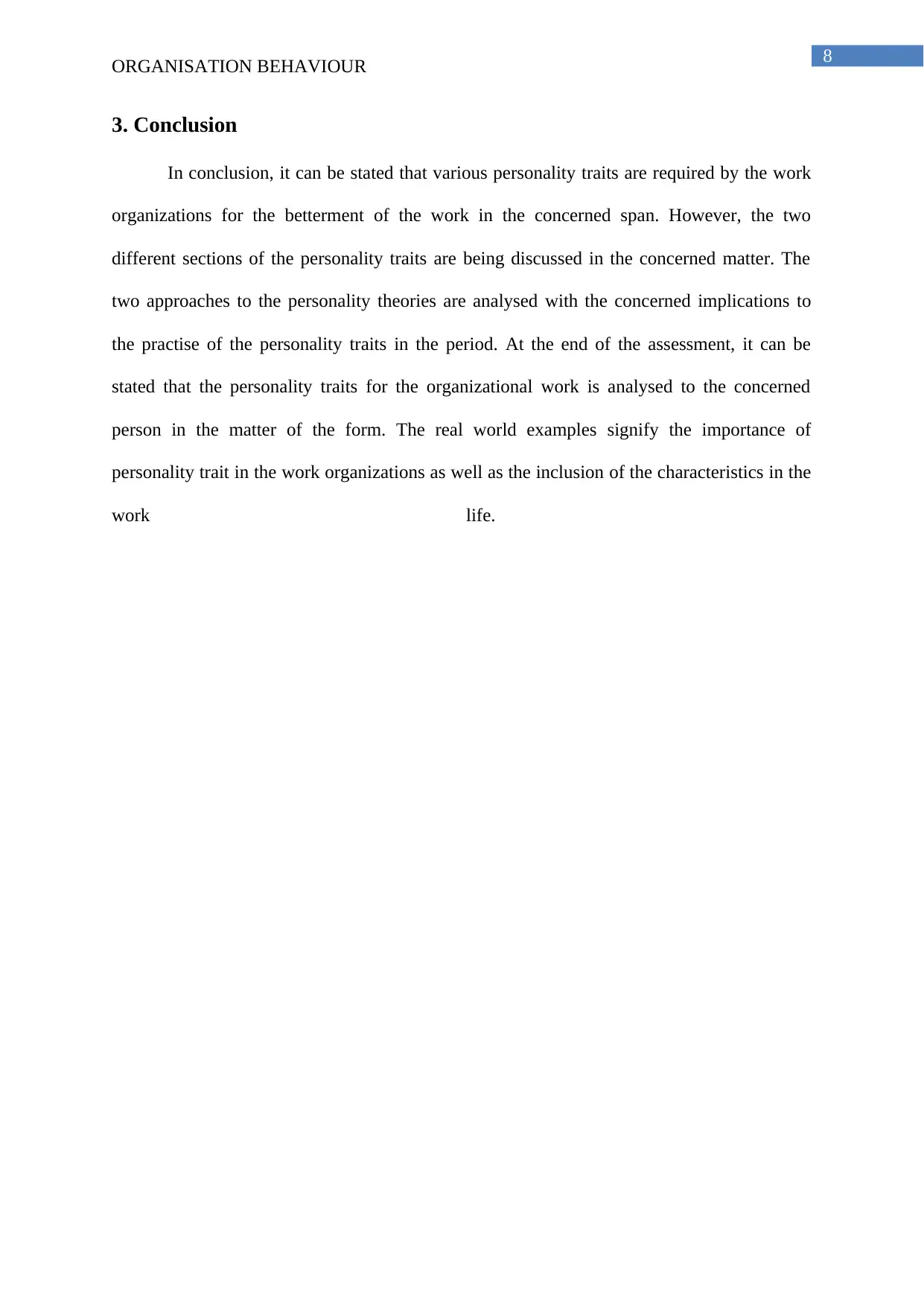
8
ORGANISATION BEHAVIOUR
3. Conclusion
In conclusion, it can be stated that various personality traits are required by the work
organizations for the betterment of the work in the concerned span. However, the two
different sections of the personality traits are being discussed in the concerned matter. The
two approaches to the personality theories are analysed with the concerned implications to
the practise of the personality traits in the period. At the end of the assessment, it can be
stated that the personality traits for the organizational work is analysed to the concerned
person in the matter of the form. The real world examples signify the importance of
personality trait in the work organizations as well as the inclusion of the characteristics in the
work life.
ORGANISATION BEHAVIOUR
3. Conclusion
In conclusion, it can be stated that various personality traits are required by the work
organizations for the betterment of the work in the concerned span. However, the two
different sections of the personality traits are being discussed in the concerned matter. The
two approaches to the personality theories are analysed with the concerned implications to
the practise of the personality traits in the period. At the end of the assessment, it can be
stated that the personality traits for the organizational work is analysed to the concerned
person in the matter of the form. The real world examples signify the importance of
personality trait in the work organizations as well as the inclusion of the characteristics in the
work life.
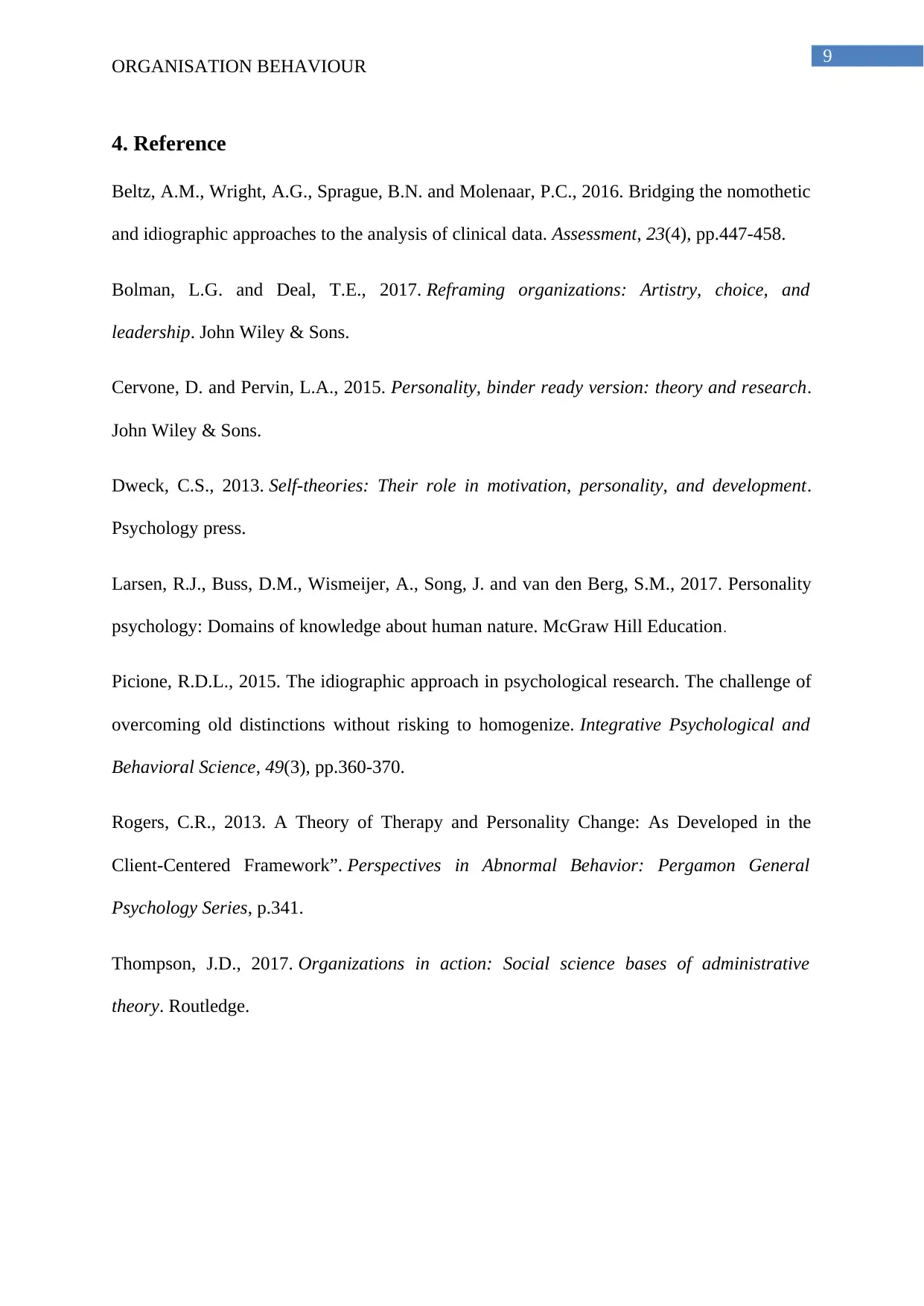
9
ORGANISATION BEHAVIOUR
4. Reference
Beltz, A.M., Wright, A.G., Sprague, B.N. and Molenaar, P.C., 2016. Bridging the nomothetic
and idiographic approaches to the analysis of clinical data. Assessment, 23(4), pp.447-458.
Bolman, L.G. and Deal, T.E., 2017. Reframing organizations: Artistry, choice, and
leadership. John Wiley & Sons.
Cervone, D. and Pervin, L.A., 2015. Personality, binder ready version: theory and research.
John Wiley & Sons.
Dweck, C.S., 2013. Self-theories: Their role in motivation, personality, and development.
Psychology press.
Larsen, R.J., Buss, D.M., Wismeijer, A., Song, J. and van den Berg, S.M., 2017. Personality
psychology: Domains of knowledge about human nature. McGraw Hill Education.
Picione, R.D.L., 2015. The idiographic approach in psychological research. The challenge of
overcoming old distinctions without risking to homogenize. Integrative Psychological and
Behavioral Science, 49(3), pp.360-370.
Rogers, C.R., 2013. A Theory of Therapy and Personality Change: As Developed in the
Client-Centered Framework”. Perspectives in Abnormal Behavior: Pergamon General
Psychology Series, p.341.
Thompson, J.D., 2017. Organizations in action: Social science bases of administrative
theory. Routledge.
ORGANISATION BEHAVIOUR
4. Reference
Beltz, A.M., Wright, A.G., Sprague, B.N. and Molenaar, P.C., 2016. Bridging the nomothetic
and idiographic approaches to the analysis of clinical data. Assessment, 23(4), pp.447-458.
Bolman, L.G. and Deal, T.E., 2017. Reframing organizations: Artistry, choice, and
leadership. John Wiley & Sons.
Cervone, D. and Pervin, L.A., 2015. Personality, binder ready version: theory and research.
John Wiley & Sons.
Dweck, C.S., 2013. Self-theories: Their role in motivation, personality, and development.
Psychology press.
Larsen, R.J., Buss, D.M., Wismeijer, A., Song, J. and van den Berg, S.M., 2017. Personality
psychology: Domains of knowledge about human nature. McGraw Hill Education.
Picione, R.D.L., 2015. The idiographic approach in psychological research. The challenge of
overcoming old distinctions without risking to homogenize. Integrative Psychological and
Behavioral Science, 49(3), pp.360-370.
Rogers, C.R., 2013. A Theory of Therapy and Personality Change: As Developed in the
Client-Centered Framework”. Perspectives in Abnormal Behavior: Pergamon General
Psychology Series, p.341.
Thompson, J.D., 2017. Organizations in action: Social science bases of administrative
theory. Routledge.
Secure Best Marks with AI Grader
Need help grading? Try our AI Grader for instant feedback on your assignments.

10
ORGANISATION BEHAVIOUR
ORGANISATION BEHAVIOUR
1 out of 11
Related Documents
Your All-in-One AI-Powered Toolkit for Academic Success.
+13062052269
info@desklib.com
Available 24*7 on WhatsApp / Email
![[object Object]](/_next/static/media/star-bottom.7253800d.svg)
Unlock your academic potential
© 2024 | Zucol Services PVT LTD | All rights reserved.





